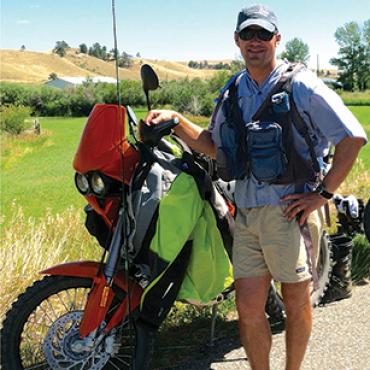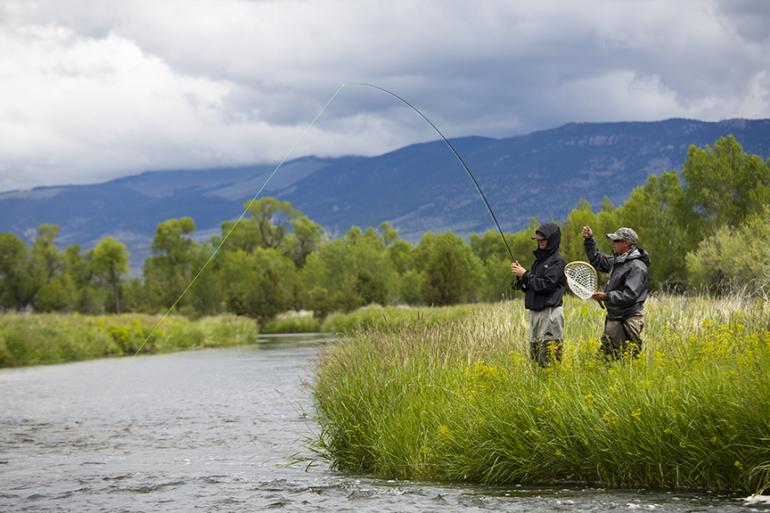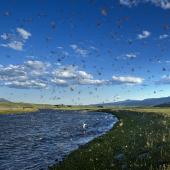Rites of Spring
Spring into early-season fishing.
Perhaps you’ve ventured out during the winter months to favored local rivers when the weather permitted, attempting some deep-water nymphing or looking for elusive midge hatch. Now it is spring, the weather truly has moderated, and you are eager to spend a full day on the water without suffering the perils of frozen appendages and icy conditions. But, alas, checking the USGS stream flow website, you’ve discovered the Yellowstone and Gallatin rivers are nearly at flood stage and driving to your nearby access produces the shocking sight of turbulent, muddy waters.
What to do? Where to go? For the angler willing to part with a little cash, the above-mentioned perennial situation presents no distress. It is time to make the trip south of Livingston to fish one or more of the three internationally renowned spring creeks of the Paradise Valley: Armstrong, Depuy’s (pronounced duh-pews), and Nelson. Although the local freestone streams remain unfishable sometimes until early July, these treasured spring creeks, originating from a deep underground aquifer, run gin-clear with water temperatures consistently hovering between 50 and 60 degrees (translation: no frozen feet while wading!). Spring hatches are replete on the creeks, with prolific baetis hatches beginning early in April and the Mother’s Day caddis in full-effect by the month’s end. And for anglers who are eager to make an early start to spring trouting, March can provide some exceptional midging and streamer action as well as the creeks’ least expensive rod fees of the year.
In addition to fine trout fishing for browns, rainbows, cutthroat, and rainbow-cutthroat hybrids, the riparian habitat along each creek offers a plethora of wildlife viewing opportunities. For the ornithologically inclined, Cliff and Tree Swallows are present, accompanied by Warblers, Fly-Catchers, Waxwings, Red-Winged Blackbirds, Thrushes, Meadowlarks, and sparrows. Sandhill cranes are likewise not uncommon, and bald and golden eagles are typically seen perched in mature cottonwoods that line the banks of the Yellowstone, which is, in many places, just a short walk away from the banks of the creeks. Complementing the avian life here are numerous whitetail deer and even the occasional moose sauntering amongst the willows, waiting to surprise the unsuspecting fly fisherman.
The best way to experience the creeks is to pack a lunch and spend the day enjoying the quiescent charm of these unique fisheries. For a real treat, bring along a grill with plans for a hot lunch, a thermos of rich coffee, and a good friend to share the memories with. Pack a whole assortment of clothing appropriate for springtime in the Rockies, and, ideally, a four-weight rod with a generous selection of midge, baetis, and caddis patterns. Also, never head to the spring creeks without a box full of scuds and sow bug imitations; a few egg patterns and an assortment of San-Juan worms never hurt either.
Rod Rates and Seasons
All three creeks—Depuy’s, Armstrong, and Nelson—maintain the same calendar and rod rates. Until April 15, at which time the “winter” season officially ends, the rod fee for each creek is a bargain at only $40. Between April 15 and June 14 the rate rises to $75, finally maxing out at $100 during the prime summer season between June 15 and September 14. All three creeks allow a limited number of rods on the water each day, ensuring that anglers have plenty of elbow room. Reservations are suggested, and just a quick phone call to any of the numbers below is all it takes to begin planning a memorable day of spring fishing.
Armstrong Spring Creek: (406) 222-2979
Depuy’s Spring Creek: (406) 222-0221
Nelson Spring Creek: (406) 222-6560
Mother's Day Caddis Hatch
Once the skies ease from gray and snowy to blue and sunny, a new blizzard of sorts erupts on southwestern Montana’s streams. “The Mother’s Day Caddis Hatch” can begin as soon as water and air temperatures increase. The last few years the hatch has commenced in late April and lasts as long as the water remains fishable. On freestone rivers like the Yellowstone, warming air temperatures increase snowmelt, and often times, one phenomenal day of dry fly fishing during this hatch will be followed by a river that has risen two feet and is full of floating tree limbs.
Most of the rivers in the area experience the Brachycentrus americanus or Brachycentrus occidentalis hatch, but freestone rivers like the Gallatin and Yellowstone seem to be the most susceptible to the synchronicity of bugs and muddy water. One river that holds up longer is the Madison. Because of the dam at Ennis, the water remains clearer longer than the rivers to the east. Often during late April and May afternoons, anglers can wade the entire river, bank to bank, casting at splashes and bulging heads. It always looks easier than it is—but that is part of the joy of fly fishing.
Another option is private spring creeks. During runoff, these are popular areas where an angler can experience the caddis hatch along with solitude and nice trout. In addition to the Paradise Valley spring creeks, Milesnick Recreation Company near Belgrade offers legendary spring creek fishing in the expansive Gallatin Valley. Their season opens on Thompson and Ben Hart creeks on May 21.
-Jeff Hostetler












